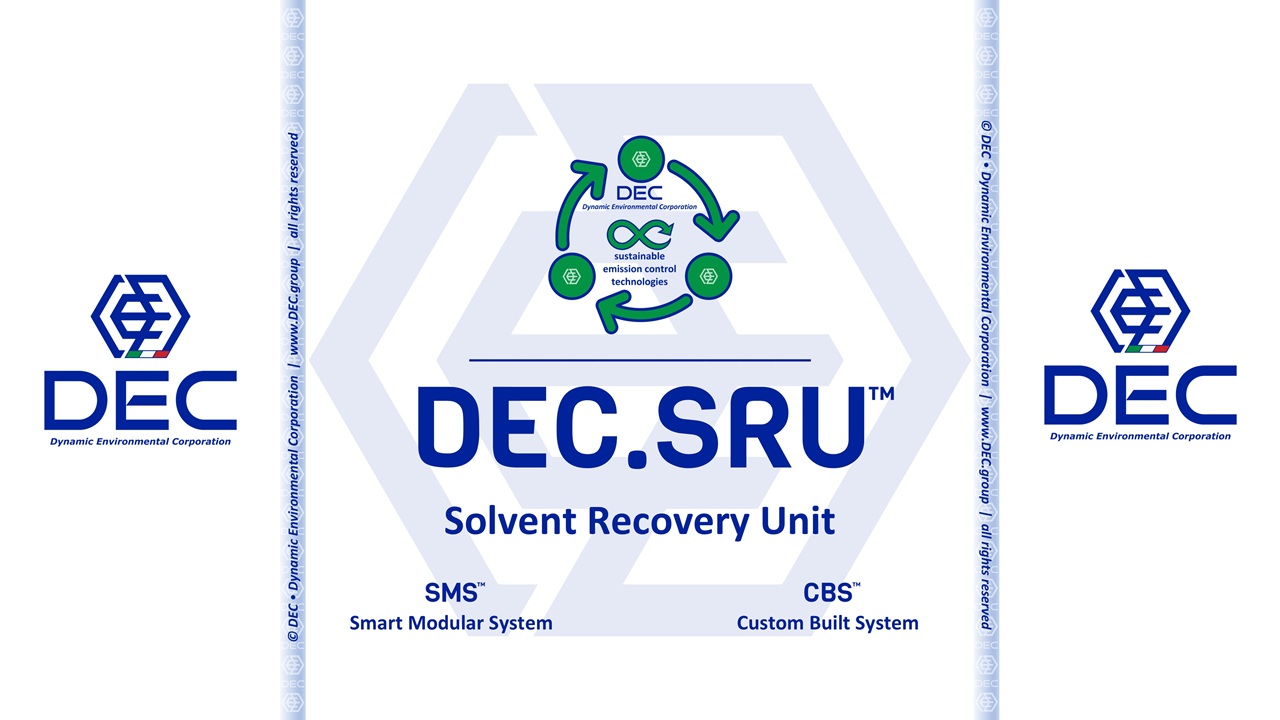
Solvent Recovery for Rotogravure printing
DEC.SRU™ ♻️ SRU | SRS | SRP
Solvent Recovery Units (DEC.SRU™), also known as Solvent Recovery Systems (SRS) or Solvent Recovery Plants (SRP), are devices used to recover solvents from air emissions of rotogravure industries.
Rotogravure printing, also known as gravure printing, is a high-quality and high-speed printing process used for flexible packaging: it involves engraving the desired image or design onto a cylinder, which is then coated with solvent based ink. The engraved cells on the cylinder pick up the ink and transfer it onto the packaging material. The result is a precise and vibrant print, with excellent color reproduction.

The solvent recovery process, used in flexible packaging converting, faces increasing scrutiny regarding Volatile Organic Compound (VOC) emissions. As sustainability and regulatory compliance become paramount, effective VOC emission control technologies are no longer optional. Among these, solvent recovery for rotogravure stands out as a crucial solution. This article delves into the intricacies of solvent recovery, addressing key questions and concerns for rotogravure operators.

how it works
SLA (Solvent Laden Air) is pushed by the fans through a multi-adsorber (activated carbon) system, to allow a high efficiency VOC (Volatile Organic Compounds) capture.
Once the adsorbent is saturated (automatically monitored by a VOC analyzer), the system is automatically cleansing the adsorbent, through a regeneration cycle. The system is using an exclusive DEC.PHD™ dehydration process (in gaseous phase), allowing the direct recovery of an anhydrous solvent mix.

conclusions
Solvent Recovery (SRU, SRP, SRS) is an indispensable tool for rotogravure printing operations striving to reduce VOC emissions, comply with regulations, and enhance sustainability. By carefully selecting and optimizing their recovery systems, operators can achieve significant environmental and economic benefits.
contact DEC
For further info: DEC.RSG™ activated carbon solvent recovery systems for rotogravure industries, nitrogen regeneration.

Understanding the Importance of Solvent Recovery
Rotogravure inks contain solvents that evaporate during the drying process, releasing VOCs into the atmosphere. These emissions contribute to air pollution and pose health risks. Solvent Recovery Units (SRU | SRS | SRP) capture and condense these vapors, allowing for direct reuse of the solvents and significantly reducing emissions.
Solvent Recovery Units (SRU | SRS | SRP) dedicated to rotogravure industries are the best solution to reduce solvent emissions (VOCs) in a sustainable way: no oxidation, no CO2 (DECarbonization).
The solvent is recovered, for direct reuse, at a fraction of its purchase cost and with a purity even higher than the fresh virgin solvent.
Choosing the Right Solvent Recovery Technology
Several technologies exist, each with its own advantages and disdvantages. A common question is, "Compare cryogenic vs. activated carbon solvent recovery for rotogravure printing VOC control effectiveness."
A common question is, "Compare cryogenic vs. activated carbon solvent recovery for rotogravure printing VOC control effectiveness."
Activated carbon systems are versatile and cost-effective, but reuiring simple regular maintenance. To optimize their performance, operators seek guidance on "How to optimize activated carbon solvent recovery for high-volume rotogravure printing operations?". Have a look to our LEL monitoring & control systems and RBC™ • Rotary Bed Concentrators.
Cryogenic direct condensation systems are not suitable for this task, even if offering high recovery rates and capable to deal with complex solvent mixtures, but they cannot handle the volume discharged by a rotogravure.
Optimizing Performance and Addressing Challenges
Maintaining optimal efficiency is critical. Operators often inquire about "Best practices for maintaining solvent recovery efficiency in rotogravure printing with varying ink formulations?" because different ink formulations (solvents in the inks and used as dilutants) may affect the recovery process.
Cost Benefits and ROI
Beyond environmental benefits, solvent recovery offers significant cost savings. Many seek to understand "What are the long-term cost benefits of solvent recovery systems for rotogravure printing VOC reduction?" and want to "Calculate ROI for investing in a new solvent recovery system for rotogravure printing VOC emission reduction." The ability to reuse solvents reduces raw material costs allowing a quick return of investment.
Regulatory Compliance and Sustainability
Strict regulations govern VOC emissions. Therefore, understanding "Regulations for VOC emissions from rotogravure printing and the role of solvent recovery technologies" is essential. Furthermore, the industry is increasingly focused on sustainability. To that end, many ask, "How does solvent recovery in rotogravure printing contribute to sustainable packaging production?"
Finding Solutions and Expertise
For those looking to implement or upgrade their solvent recovery systems, questions like "Where to find suppliers of custom-designed Solvent Recovery Units for rotogravure printing applications?" are common. Real world examples are also helpful, so many search for "Case studies of successful solvent recovery implementation in flexible packaging rotogravure printing."
Troubleshooting and Training
Even with DEC advanced systems, challenges can arise. Operators often seek resources on "Troubleshooting common issues with solvent recovery systems in rotogravure printing workshops and training: check TSS • Reliable Support for Your Environmental Needs.
LTKW
Check our website to look for "Selecting the right solvent recovery system capacity for a specific rotogravure printing press output", "Impact of solvent purity levels from recovery systems on rotogravure print quality and consistency", "How to integrate a new Solvent Recovery Unit into an existing rotogravure printing line efficiently", "Solvent recovery system maintenance schedules and preventative measures for rotogravure printing plants", "The role of automated monitoring in optimizing solvent recovery performance in rotogravure printing", "Environmental compliance audits for rotogravure printing operations focusing on solvent recovery effectiveness", "Cost analysis of different solvent abatement methods vs. solvent recovery for rotogravure printing VOC reduction", "Energy efficiency of solvent recovery systems for rotogravure printing and strategies for reduction", "Solvent recovery for water-based inks in rotogravure printing: challenges and solutions".
